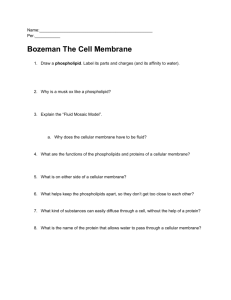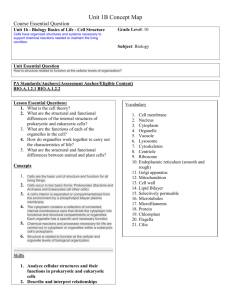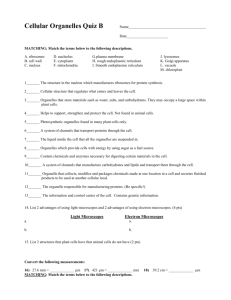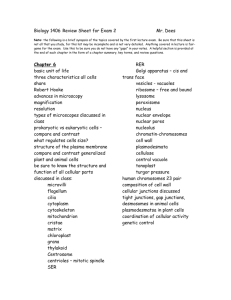Cell Biology Unit – PDQ's 1-5 Cells 1 – Overview and
advertisement
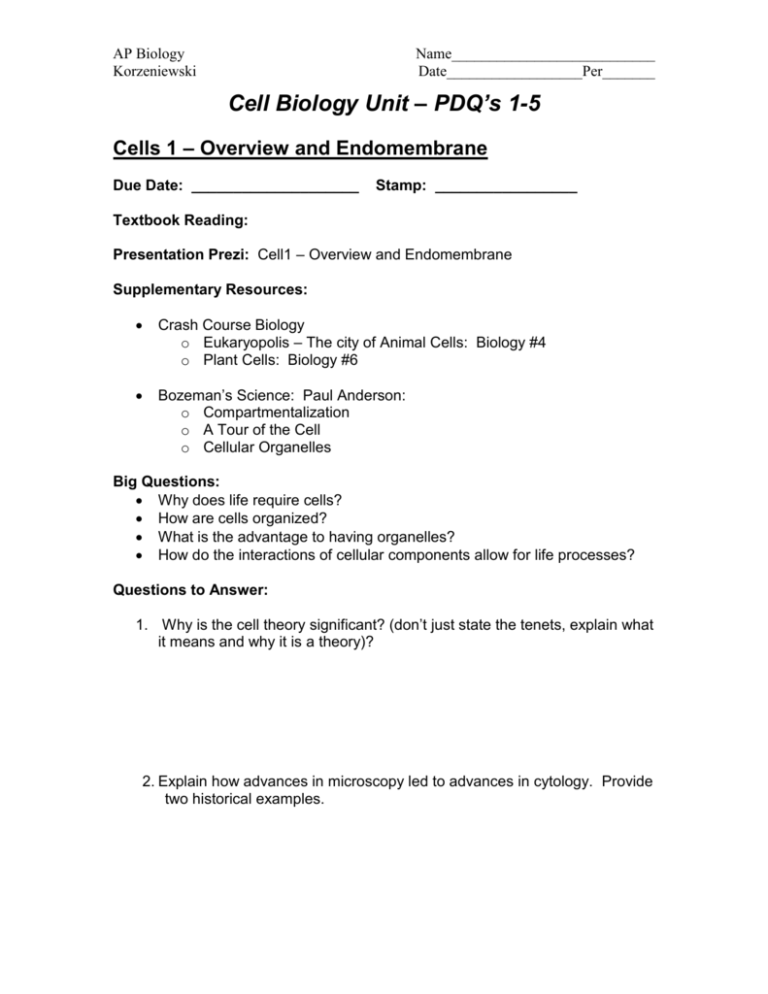
AP Biology Korzeniewski Name___________________________ Date__________________Per_______ Cell Biology Unit – PDQ’s 1-5 Cells 1 – Overview and Endomembrane Due Date: ____________________ Stamp: _________________ Textbook Reading: Presentation Prezi: Cell1 – Overview and Endomembrane Supplementary Resources: Crash Course Biology o Eukaryopolis – The city of Animal Cells: Biology #4 o Plant Cells: Biology #6 Bozeman’s Science: Paul Anderson: o Compartmentalization o A Tour of the Cell o Cellular Organelles Big Questions: Why does life require cells? How are cells organized? What is the advantage to having organelles? How do the interactions of cellular components allow for life processes? Questions to Answer: 1. Why is the cell theory significant? (don’t just state the tenets, explain what it means and why it is a theory)? 2. Explain how advances in microscopy led to advances in cytology. Provide two historical examples. 3. Why are certain cellular structures unable to be observed with a light microscope? 4. How does the ratio of a cell’s surface area to volume place upward and downward limits on cell size? 5. How do organelles allow for increased complexity in cells? 6. Provide four examples of cell tasks that are accomplished by proteins. 7. Explain/Diagram the relationship between DNA, RNA and protein in cells. 8. How does the structure of the nucleus allow it to fulfill its function? 9. True or False: The nucleolus is an intranuclear organelle. Explain your answer. 10. Why do ribosomes exist in the free and bound configurations in eukaryotic cells. 11. How does the structure of the endoplasmic reticulum (smooth and rough) allow it to fulfill its function? 12. How does the structure of the golgi apparatus allow it to fulfill its function? 13. Why are vesicles necessary? 14. Diagram the endomembrane system. Include all organelles and processes that function in the system. Make Sure You Can: Explain the cell theory. Compare different types of microscopy Explain why there are no giant cells around. Refine your contrast of prokaryotic and eukaryotic cells. Relate the structure and function of the organelles in this presentation. Explain the interactions of the organelles in this presentation. Explain how the organelles in this presentation provide for essential life processes. Cells 2 – Matter and Energy Processing Due Date: ____________________ Stamp: _________________ Textbook Reading: Presentation Prezi: Cell 2 – Matter and Energy Processing Supplementary Resources: Crash Course Biology o Eukaryopolis – The City of Animal Cells: Biology #4 o Plant Cells: Biology #6 Bozeman’s Science: Paul Anderson: o Compartmentalization o A Tour of the Cell o Cellular Organelles Big Questions: What is the relationship between matter and energy? Why does life require matter? Why does life require energy? How do the interactions of cellular components allow the cell to process matter and energy? Questions to Answer: 1. Why do cells need energy and where do they get it from? 2. Why will it make me cringe if you ever say that cells “make” energy? 3. Why do cells need ATP? Why can’t they just use glucose for their energy needs? 4. How is the structure of a lysosome related to its function? 5. How does a cell use peroxisomes? 6. Explain one normal function of lysosomes in a multicellular organism and one abnormal function. 7. Explain the functions of vacuoles and explain how they differ between plant cells and animal cells. 8. Draw a mitochondria. Label the matrix, cristae, inner membrane, outer membrane and intermembrane space. 9. How is the structure of a mitochondria related to its function? 10. Draw a chloroplast. Label the stroma, thylakoids, grana, outer membrane, inner membrane, and where chlorophyll can be found. 11. Why are mitochondria and chloroplasts separate from the endomembrane system? 12. Why are mitochondria and chloroplasts referred to as “semi-autonomous” organelles? 13. Diagram the relationship between the processes that occur in the mitochondria and the processes that occur in the chloroplast. Cells 3 – Structure and Support Due Date: ____________________ Stamp: _________________ Textbook Reading: Presentation Prezi: Cell 3 – Structure and Support Supplementary Resources: Crash Course Biology o In Da Club – Membranes & transport: Biology #5 Bozeman’s Science: Paul Anderson: o A Tour of the Cell o Cellular Organelles Big Questions: What does the internal structure of a cell look like? How do cells separate themselves from their environments? How do cells communicate with the environment? How do cells communicate with other cells? Questions to Answer: 1. How does the structure of the cytoskeleton enable its functions? 2. How do the structures of cilia and flagella enable their functions? 3. Of the three kinds of filaments that make up the cytoskeleton, which kind comprise centrioles in animal cells? What is the function of a centriole? 4. Diagram an individual phosopholipid and a bilayer of phospholipids. Label the hydrophillic head, and hydrophobic tails in both. 5. What criteria of a substance determines if it will be able to pass through the phospholipid bilayer. Give two examples of substances that can move through the bilayer and two examples of substances that can’t. 6. Explain the Fluid Mosaic model of the cell membrane and describe the functions of the proteins that are embedded in the membrane. 7. How is it possible that a protein can be embedded in the plasma membrane and also have regions that are attracted to the intracellular and extracellular regions of a cell? 8. Diagram the cell membrane. Label the following parts: lipid bilayer, integral proteins, peripheral proteins, cholesterol, cytoskeleton, extracellular matrix, glycoproteins, glycolipids. Explain the function of each part of the cell membrane in contributing to the functioning of the cell. 9. If cells can not visually inspect other cells, how do the cells of our immune system know if a particular cell they encounter is part of us or part of another organism? 10. Compare and contrast the cell wall and the extracellular matrix. Provide at least one similarity and one difference. 11. Make a table comparing and contrasting tight junctions, gap junctions, desmosomes and plasmodesmata. Include the type of cells they are found in, their structures, functions and if they are open for material transport or closed. Make Sure You Can Explain why cells need to have internal structural organization and support. Explain the structure and function of the cytoskeleton. Compare the components of the cytoskeleton. Explain the structure and function of the cell membrane. Describe the roles of phospholipids, cholesterol, and membrane proteins in cell membrane function. Explain the structure and function of the cell wall. Compare the structures of plant-like, fungal, and bacterial cell walls. Explain the structure and function of the extracellular matrix. Compare the structure and function of different types of intercellular junctions. Cells 4 – Transport Due Date: ____________________ Stamp: _________________ Textbook Reading: Presentation Prezi: Cell 4 – Transport Supplementary Resources: Crash Course Biology o In Da Club – Membranes & transport: Biology #5 Bozeman’s Science: Paul Anderson: o Cell Membranes o Transport Across Cell Membranes Big Questions: How does the cell control what is transported at the cell membrane? Why is transport of materials between the cell and its environment necessary for life? How does the environment influence living systems? How do cells exist within the confines of the Laws of Thermodynamics? Questions to Answer: 1. How does the second law of thermodynamics allow for diffusion of substances? 2. Explain the major difference between simple diffusion and facilitated diffusion. 3. How is active transport possible, since it contradicts the tendencies of the second law of thermodynamics? 4. Where does the energy to power active transport come from? 5. Diagram one complete cycle of the Sodium-Potassium pump. Is this active or passive transport? 6. What is osmosis? What is tonicity? 7. Explain the meaning of the statement: “Tonicity is only useful as a comparative term.” 8. Is it possible for a solution to be both hypertonic and hypotonic? Why or Why not? 9. Why do animal cells prefer to be in isotonic solutions, while plant cells prefer to be in hypotonic solutions? 10. How does a paramecium deal with its hypotonic environment? 11. How do large molecules get taken into the cell? Make Sure You Can: Explain how the consequences of the second law of thermodynamics allow diffusion to occur in the universe without an input of energy. Compare passive and active transport Compare facilitated and simple diffusion Compare diffusion of a solute with osmosis of water. Determine the tonicity relationships when given the concentrations of solutes of multiple solutions. Predict the movement of specific molecules when given information about their relative concentrations and the characteristics of a given semipermeable membrane. Explain why animals and plants have evolved adaptations to survive in solutions of different tonicities. Predict the effect of altering tonicity on a plant or animal cell. Compare exocytosis and endocytosis. Explain the purposes and processes of the different modes of endocytosis employed by the cell. Cells 5 – Cellular Communication Due Date: ____________________ Stamp: _________________ Textbook Reading: Presentation Prezi: Cell 5 – Cellular Communication Supplementary Resources: Bozeman’s Science: Paul Anderson: o Cell Communication o Evolutionary Significance of Cellular Communication o Signal Transduction and Gene Expression Big Questions: Why do cells communicate? What does cellular communication look like? How is cellular communication utilized in unicellular and multicellular life? Questions to Answer: 1. Why do cells need to communicate? 2. Explain what happens during the three phases of signal transduction. 3. What’s a ligand? 4. How are signaling pathways used in organisms? 5. Compare G-Protein Linked Signaling pathways, Tyrosine Kinase signaling pathways and ligand-gated ion channel signaling pathways. 6. What is the purpose of second messengers? 7. Diagram the epinephrine signaling pathway. Diagram signal reception, transduction and response. 8. How is the amplification of a signal possible? What kind of feedback is signal amplification? 9. How is it possible that one signal can have multiple effects in an organism? 10. Define each of the following phenomena, identify the organisms that they occur in, and explain how cellular signaling is used in each of them: 1. Quorum Sensing 2. Mating in Yeast 3. Apoptosis 11. Why do you think cellular signaling pathways and mechanisms are so universal among life’s domains? Make Sure You Can Explain why and how cells communicate with the environment. Explain the common features shared among cellular communication processes. Compare the purpose of cellular communication in unicellular and multicellular organisms. Describe the major features of signal transduction pathways in cells. Connect cellular signaling pathways to actual examples as discussed in this presentation. Discuss the evolutionary/adaptive considerations of cellular signaling pathways.
